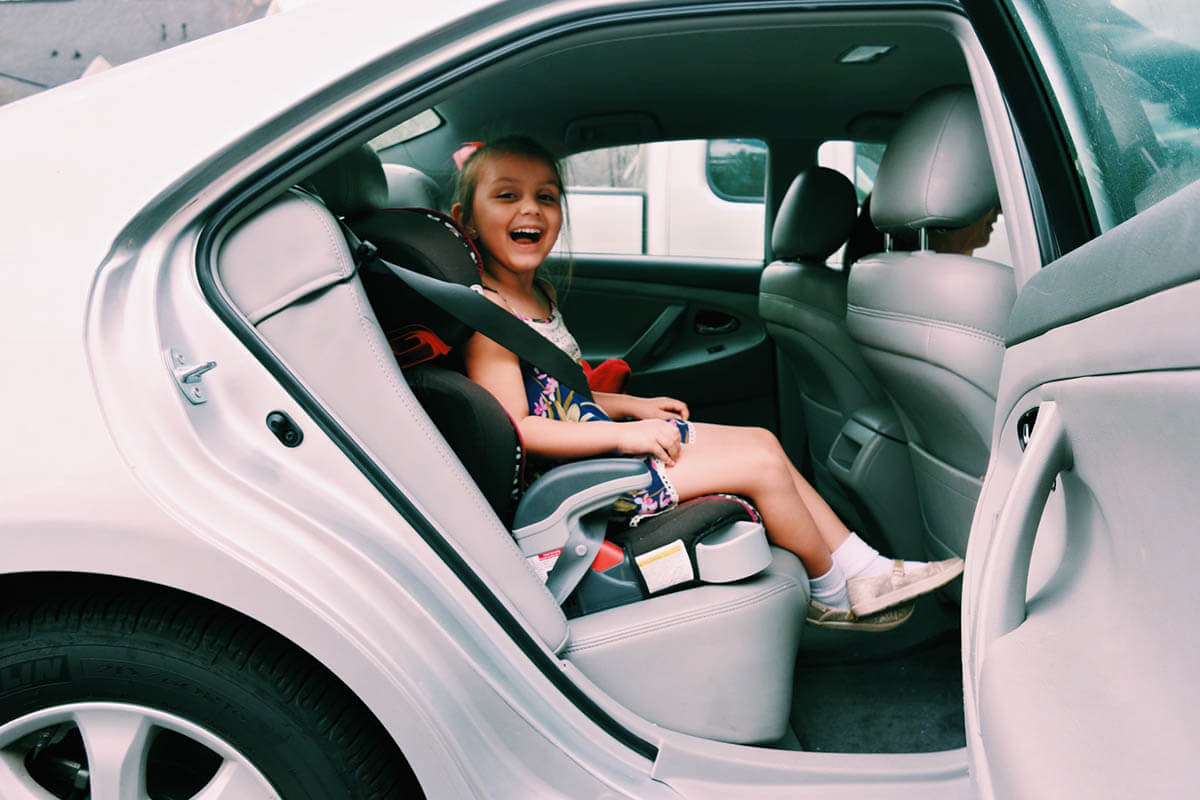
Minding child safety seat laws is of vital importance. Once your child is old enough to occupy a separate seat in the car, you must learn about how and where to do it. Even if your children can’t sit by themselves, it doesn’t mean that they should always be on the mom’s lap.
Taking into account that there are 50 states in the US + D.C., the child safety seat laws vary from one state to another. Thus, we at Caring Parents’ Choice have come up with a list of main rules for each state in America to make your life easier and help you avoid unnecessary fines.
Child Safety Seat Laws in the United States of America
Alabama
1. The Cotton State recognizes that infants weighing up to 20 pounds must occupy a rear-facing seat in a vehicle.
2. Meanwhile, kids from 1 to 5 years old with a weight of no more than 40 pounds have to sit in a forward-facing seat in a vehicle.
3. For kids aged 5 and more, the law requires occupying a booster seat in a vehicle.
4. Other children from 6 to 15 years old must use the belt no matter where they sit in a vehicle.
Alaska
1. According to the child safety seat laws in the Last Frontier State, kids up to 1 year who weigh around 20 pounds have to sit in a rear-facing seat in a vehicle, just like in Alabama.
2. Kids from 1 and up to 5 years old with a weight of 20 pounds and more must be in a forward-facing seat in a vehicle.
3. Those aged 5-8 years with a weight of up to 65 pounds or a height of up to 57 inches are supposed to sit in a booster seat in a vehicle.
4. Kids aged 4-16 years weighing over 65 pounds and having a height of over 57 inches are required to use adult seat belts.
Arizona
1. The laws in the Grand Canyon State say that kids aged up to 5 years are obliged to occupy a seat in a vehicle.
2. Kids aged 5-8 years who are shorter than 57 inches have to sit in a booster seat in a vehicle.
3. Children over 5 years old and taller than 57 inches are required to use adult belts in a vehicle.
Arkansas
1. Here, kids under 5 years old who weigh less than 60 pounds have to occupy a seat in a vehicle.
2. The Natural State requires those aged 5-8 years with a height of up to 57 inches to use a booster seat in a vehicle.
3. Seat belts for adults must be used by everyone aged 6-15 years who weigh over 60 pounds.
California
1. The Golden State’s Regulations mention that kids aged around 2 must occupy a rear-facing seat in a vehicle.
2. Kids aged up to 8 who are no taller than 57 inches have to sit in a forward-facing seat in a vehicle.
3. Those under 8 years old are required to use safety belts while sitting in the back seat.
4. Kids from 8 and up to 16 years old must use adult seat belts.
Colorado
1. In Colorado, or the Centennial State, kids under 1 who weigh up to 20 pounds must occupy a rear-facing seat in a vehicle.
2. Those aged from 1 to 4 weighing up to 40 pounds can either be in a rear-facing or a forward-facing seat in a vehicle.
3. For kids aged over 4 who weigh more than 40 pounds, a choice stands between a forward-facing and a booster seat in a vehicle.
4. Kids who are over 8 and under 16 years old are required to use adult belts in a vehicle.
Connecticut
1. When you’re driving with a child on board in the Nutmeg State, remember that your child must occupy a rear-facing seat in a vehicle if they are aged around 2 and weigh up to 20 pounds.
2. To be in a forward-facing seat, a kid must be older than 2 and weigh up to 40 pounds.
3. Starting from the age of 5 and the maximum weight of 60 pounds, a child should sit in a booster seat.
4. Kids over 8 years old who weigh more than 60 pounds have to use adult safety belts.
Delaware
1. If you’re in the Diamond State, bear in mind that kids up to 8 years old with a weight of up to 65 pounds must be in the child safety seat.
2. Those over 8 years old and 65 pounds are obliged to use the seat belt system of the vehicle.
D.C.
1. D.C. laws like the belt system of a vehicle for kids up to 16 years old apply.
2. Kids up to 8 years old must be in a booster seat.
Florida
1. In the Sunshine State, every driver who has kids aged up to 6 onboard has to place them in a child safety seat.
2. Kids from 6 to 16 years old must use adult belts.
Georgia
1. The Empire State of the South states that kids up to 8 years old must sit in the back seat.
2. When a kid becomes taller than 57 inches, they can use belts.
Hawaii
If you happen to drive along the Aloha State roads with children onboard, that’s what you should remember:
1. A kid under 4 years old must be in a child safety seat.
2. Kids aged 4-8 can also use a booster seat in a vehicle.
3. Older children or those who are taller than 57 inches and heavier than 40 pounds must use seat belts.
Idaho
In the Gem State, you must put your kid aged up to 6 into a seat of the vehicle. If your kid is over 8 years old and sits in the back seat, he/she is obliged to use belts.
Illinois
1. The laws in the Land of Lincoln dictate that kids up to 2 years old have to sit in a rear-facing car seat.
2. Those whose weight is more than 40 pounds should use belts.
Indiana
Everything’s simple in the Hoosier State: if your kid is aged up to 8, they occupy a child safety seat; if a child is aged 8-16, they must use safety belts.
Iowa
The Corn State has the following child safety seat laws:
1. Kids aged up to 1 and weighing up to 20 pounds ride in a rear-facing seat.
2. Those aged 1-6 sit in a forward-facing seat.
3. Older kids up to 17 years old are obliged to use belts.
Kansas
What about the Jayhawker State?
1. Kids up to 4 years old are to be in a rear-facing seat.
2. Those who are aged from 4 to 8 and weigh up to 80 pounds must ride in a forward-facing seat.
3. Kids older than 8 use belts.
Kentucky
1. Kentucky, or the Bluegrass State, requires drivers to place their children under 40 inches tall in a child safety seat.
2. Other kids up to 8 years old must be in a booster car seat.
Louisiana
The Sugar State has quite a few child safety seat laws regarding child safety in vehicles:
1. Kids up to 2 years old sit in a rear-facing seat.
2. Children between 2 and 4 years old occupy forward-facing seats in vehicles.
3. Those aged 4-9 are in booster seats.
4. Older kids use belts.
Maine
1. It’s illegal to have a 40-pound (or less) child anywhere but in a child safety seat in the Pine Tree State.
2. Also, make sure your kids aged up to 8 sit in a booster seat.
3. And, don’t forget to make those from 8 to 18 years old use safety belts on the road.
Maryland
The Free State is indeed free in terms of child safety seat laws compared to other states. Here, you only have to make sure that your kids under 16 are in a child safety seat and buckled up.
Massachusetts, Michigan, Minnesota, New Hampshire
In the Old Colony State, you follow the same child safety seat laws as in Maryland. The same applies to Michigan, Minnesota, and New Hampshire.
Mississippi
When you’re driving the Magnolia State roads, put your underage kids in a child safety seat unless they weigh more than 65 pounds and are taller than 57 inches.
Missouri
The Show-Me State requires you to abide by the following child safety seat laws:
1. Kids aged up to 4 who are up to 40 inches tall sit in child safety car seats.
2. Those from 4 to 7 years old sit either in a car seat or a booster seat.
3. Kids aged 8-16 must use belts.
Montana
In the Treasure State, you must only watch kids up to 5 years old to be in a child safety seat.
Nebraska
Here in the Beef State, be sure to place a 2-year-old or smaller kid in a rear-facing seat to avoid problems with the law. Besides, make sure your older underaged kids use belts, okay?
Nevada
Want to know how to behave in the Battle Born State? Just put your kids up to 12 years old in the back seats of the vehicle.
New Jersey
New Jersey, or the Garden State, requires you to do the following:
1. Put infants in rear-facing seats.
2. Make sure your toddlers are in forward-facing seats.
3. Place other children up to 8 years old in booster seats.
New Mexico
The Sunshine State law will not punish you if you:
1. Place kids under 1 into a rear-facing seat.
2. Watch kids up to 4 to be in forward-facing seats.
3. Put kids between 5 and 6 years old in booster seats.
4. Belt up those up to 12 years old and older.
New York
The roads in the Empire State have their specific rules, namely:
1. Never place infants anywhere but rear-facing seats in a vehicle.
2. Don’t put kids up to 4 years old anywhere that is not a forward-facing car seat.
3. Avoid driving with kids between 4 and 8 years old if they’re not in a booster seat.
4. You won’t lose your driving license if you make your kids aged up to 16 years to use safety belts.
North Carolina
1. In the Old North State, nothing will happen to you in terms of fines if your underaged kids who are up to 16 years old use belts.
2. Kids who are under 8 years old and weigh up to 80 pounds ride in child safety seats.
3. Younger children (up to 5 years old) must sit only in the back seat of the vehicle.
North Dakota
North Dakota, or the Flickertail State, is lawfully safe for you and your family if your kids up to 8 years old are in child safety seats. Besides, older kids aged 8-17 must use belts. Please, bear it in mind!
Ohio, Oklahoma, Oregon, Pennsylvania, Rhode Island, South Carolina
Child safety seat laws on the road are pretty classic in the Buckeye State.
1. Please, place your 4-year-olds and younger children in either rear-facing or forward-facing car seats.
2. Those who are 4-8 years old must be seated in boosters.
3. For older kids (up to 15), it is obligatory to use safety belts in a vehicle.
The same rules apply in Oklahoma, Oregon, Pennsylvania, Rhode Island, and South Carolina.
South Dakota
In South Dakota, or the Mount Rushmore State, there are fewer child safety seat laws than in the previous 6 states:
1. You should remember to place kids under 5 years old in a special car seat.
2. Besides, don’t forget to tell your older children aged up to 18 to buckle up.
Tennessee
There are pretty much the same child safety seat laws regarding child safety in vehicles in the Volunteer State as it is in Ohio and the other 5 states. The only difference is that the seat belt system is required for kids aged over 9.
Texas
1. When you’re hitting the road in the Lone Star State, you should buckle up your older kids aged 8-17.
2. Younger children must be placed in a child safety seat.
Utah
In the Beehive State, do pretty much the same things as you would’ve done in Texas. However, make your 8-year-old or younger kids use seat belts if they’re taller than 57 inches.
Vermont, Virginia
Vermont, or as we call it, the Green Mountain State, is more about child safety seat laws on the road than Utah, and here is why:
1. Rear-facing seats are to be occupied by infants weighing up to 20 pounds.
2. Forward-facing seats, on the other hand, must serve as sitting places for kids aged 1-8.
3. Everyone beyond the age of 8 and under 18 years old must use belts in a vehicle.
The same rules work in Virginia.
Washington
The Chinook State has recently updated its child safety seat laws for drivers. Now, they look like this:
1. All kids aged 13 and less have to sit in the back seat.
2. Infants are to be seated in rear-facing seats.
3. Kids aged 2-4, as well as older kids that are shorter than 57 inches, have to sit in booster seats.
West Virginia
There are fewer child safety seat laws in the Mountain State than in Washington. You only need to remember that kids under 8 years old must be in a child safety seat, while those older than 8 but younger than 18 must use belts.
Wisconsin
America’s Dairyland has pretty strict child safety seat rules.
1. First off, kids up to 4 years old weighing up to 40 pounds must sit in rear-facing seats.
2. Secondly, children aged 4-8 who weigh up to 80 pounds are to occupy forward-facing seats.
3. Also, those who are under 8 years old but heavier than 80 pounds must be in boosters and belted up.
4. Others are to be belted up.
Wyoming
In the Equality State, all you need to do to follow the child safety seat laws is to put your kids younger than 8 years old in child safety seats.
That’s a hell lot to remember, huh? Use this table to learn the child safety seat laws of each state quickly. Another thing is to care about the comfort of your children and choose car seats that are adjusted to their height and weight. Don’t forget about harness requirements if there are any!
No matter where you go, make your safety and the safety of your children a priority. There’s no need to rush and make rash decisions, okay? This way you’ll 100% avoid any road accidents and be safe and sound in any state of America. Good luck!





